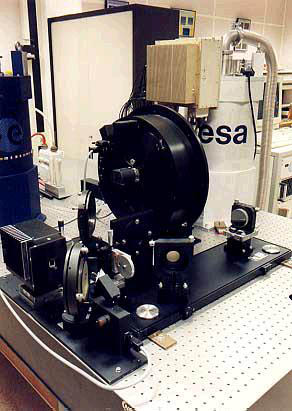| 11 July
2001 |
S-CAM,
the Worlds most advanced optical camera, captures eclipse of binary
star. |
Astronomers from the Mullard Space Science Laboratory joined
a team from the European Space Agency
in La Palma, Spain to use a totally new type of optical detector on
the William Herschel Telescope, part of the Isaac
Newton Group of Telescopes (ING).
The
new instrument, named S-CAM
(Superconducting tunnel junction-CAMera) uses advanced detector elements
based on superconducting technology to register the arrival of individual
photons, and measure their wavelength (colour). These detectors are
the first to detect colour intrinsically in the optical band.
The instrument is cooled to below one degree kelvin to minimise all
possible noise, resulting in an almost perfect detector.
The
astronomers were looking at extremely faint astronomical sources, which
vary rapidly, for example pulsars or binary star systems. These observations
would not have been possible using conventional optical CCD detectors,
because very rapid changes in light intensity cannot be measured.
 S-CAM (Photograph courtesy ESA).
S-CAM (Photograph courtesy ESA).
Dr.
Mark Cropper, from the Mullard Space Science Laboratory, has been studying
binary star systems, known as magnetic cataclysmic variables, for more
than a decade. "This new detector allows us to look at changes
in the light from the system as it changes over small fractions of a
second. This is the first time we have been able to study the rapid
colour changes, which occur at the same time. From this we have been
able to find out which parts of the system are emitting at what brightness
and at what temperature - a sort of dissection process." Dr Cropper
added "that this allowed the energy generation and emission in
these binary stars to be much better understood." Such details
are far too small to be seen in normal images from telescopes on the
ground or in space.
|
Contacts:
|
|
| |
|
| Dr
Mark Cropper |
01483
204155 email: msc@mssl.ucl.ac.uk |
|
MSSL
switchboard
|
01483
274111
|
|
MSSL
website
|
|